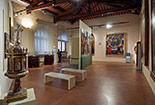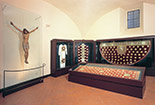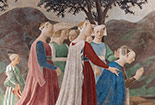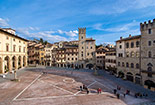A MUSEUM DEDICATED TO SACRED ART
in Arezzo, Tuscan art city that you can know in every detail with this website
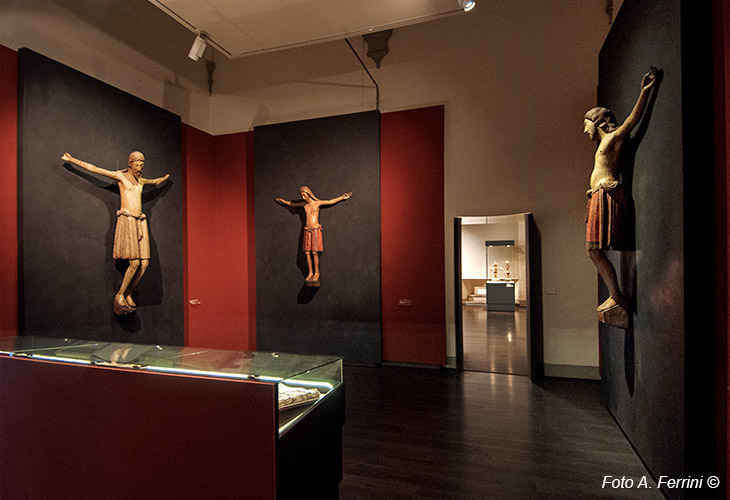
Texts and photos by Alessandro Ferrini ©
22 images in sequence of Museo Diocesano di Arezzo accuratamente descritte. Clicca per ingrandire
The Diocesan Museum, an exhibition of sacred art in the Land of Arezzo
 In front of the facade of San Donato’s Cathedral in Arezzo is the Bishop's Palace. Inside this has found place since 2011 the MUDAS, the new Diocesan Museum of Sacred Art. Until then, the exhibition was located in some rooms adjacent to the sacristy of the Duomo.
The Diocesan Museum of Arezzo occupies five rooms on two floors where we can admire works made from the twelfth to the nineteenth century. All these works are related to sacred art, but of very different types such as paintings on wood and canvas, frescoes or detached from the palace. There are also sculptures made on various types of material. There are clearly objects closely related to religious life such as wallpapers, chalices, monstrances, reliquaries, crosses of various kinds. The enormous and precious manuscripts are also very fascinating.
In front of the facade of San Donato’s Cathedral in Arezzo is the Bishop's Palace. Inside this has found place since 2011 the MUDAS, the new Diocesan Museum of Sacred Art. Until then, the exhibition was located in some rooms adjacent to the sacristy of the Duomo.
The Diocesan Museum of Arezzo occupies five rooms on two floors where we can admire works made from the twelfth to the nineteenth century. All these works are related to sacred art, but of very different types such as paintings on wood and canvas, frescoes or detached from the palace. There are also sculptures made on various types of material. There are clearly objects closely related to religious life such as wallpapers, chalices, monstrances, reliquaries, crosses of various kinds. The enormous and precious manuscripts are also very fascinating.
The most famous artists of Arezzo, and others who gravitated in the Land of Arezzo, are present in this exhibition easily accessible by leaving the car in the large parking lot of Via Pietri located just outside the north walls of the city. From here you can quickly reach the historic center with comfortable escalators that lead us to Piazza del Duomo (between the Cathedral and the Bishop's Palace) where the Diocesan Museum is located at number 1.
As already mentioned, the visit to the museum is divided into five rooms that offer a clear glimpse of art, history and religion in the territory of Arezzo.
The beginning of this museum itinerary is marked by a very evocative room where on dark walls hang between large wooden crucifixes painted very ancient, twelfth and thirteenth centuries. Near these are exhibited in a shrine precious illuminated manuscripts. We will then meet an Annunciation on wood by Andrea di Nerio and two detached frescoes by Spinello Aretino: a Madonna and Child between San Giacomo and Antonio Abate and an Annunciation. Then a panel with the Madonna and Child with the Evangelists by Stefano di Antonio di Vanni and an Annunciation, a terracotta relief by Bernardo Rossellino. In room 2 we can see a bust of San Donato in terracotta attributed to Luca della Robbia and one of the most extraordinary  works of the Diocesan Museum of Arezzo: a detached fresco of San Girolamo penitent of the Florentine painter Bartolomeo Della Gatta, but considered of Arezzo because in this city he had his own workshop. After Piero della Francesca, Della Gatta was the most famous artist in this part of Tuscany in the second half of the fifteenth century.
works of the Diocesan Museum of Arezzo: a detached fresco of San Girolamo penitent of the Florentine painter Bartolomeo Della Gatta, but considered of Arezzo because in this city he had his own workshop. After Piero della Francesca, Della Gatta was the most famous artist in this part of Tuscany in the second half of the fifteenth century.
The third room of the museum is characterized by the presence of Giorgio Vasari. The great artist from Arezzo has here two canvases that are part of a single banner on which the painter painted the Baptism of Jesus and the sermon of the Baptist. Still Vasari is a Madonna of Mercy painted on a large round canvas. Also in this room there is a work by the Florentine painter Santi di Tito where Jesus Christ is represented in Marta's house.
The last rooms of the MUDAS, on the upper floor, are of great interest for their completely frescoed walls (in particular the hall used for conferences), for the presence of three oil paintings on canvas by Pietro Benvenuti from Arezzo (1769 - 1844) and for the exhibition of many liturgical objects.



